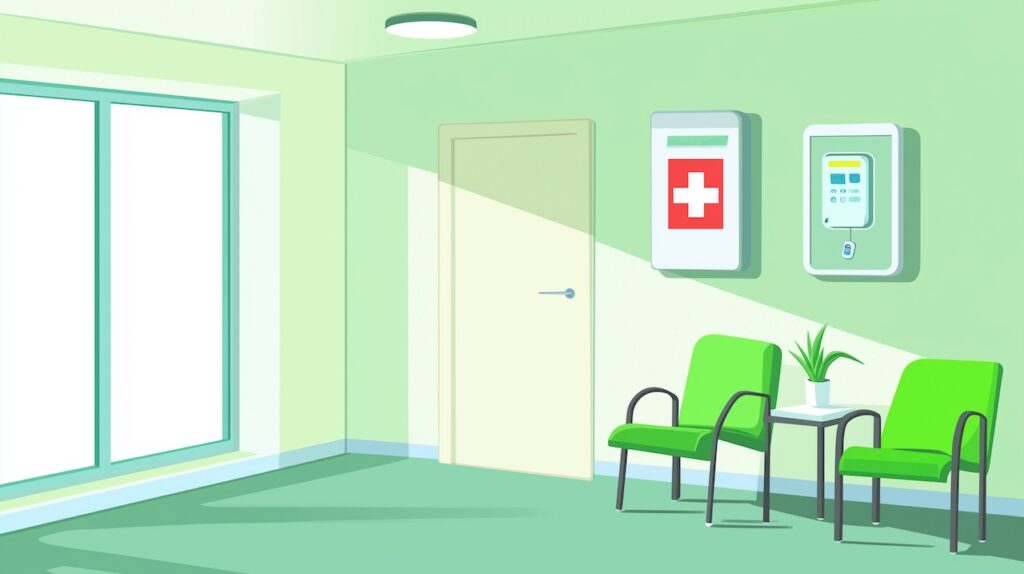Sudden cardiac arrest is a life-threatening emergency that requires immediate action.
Automated external defibrillators (AEDs) are portable devices that can analyze heart rhythms and deliver a shock to restore normal heart function.
They are designed for use by anyone, even without medical training, and are increasingly available in public places.

Philips, a leading manufacturer of AEDs, offers two popular models: the HeartStart OnSite and the HeartStart FRx.
In this article, we’ll compare the features of the OnSite and FRx to help you choose the best one for your needs.
The Importance of AEDs in Saving Lives
Sudden cardiac arrest (SCA) is a life-threatening emergency that occurs when the heart unexpectedly stops beating, often due to an abnormal heart rhythm called ventricular fibrillation.
Without immediate treatment, SCA can lead to death within minutes.
This is where automated external defibrillators (AEDs) play a crucial role in saving lives.
AEDs are portable, battery-operated medical devices designed to analyze the heart’s rhythm and deliver an electric shock to restore normal heart function.
These user-friendly devices are intended for use by trained first responders and untrained bystanders, making them invaluable tools in public spaces like schools, airports, and shopping malls.
When someone collapses from SCA, every second counts. According to the American Heart Association, the chance of survival decreases by 7-10% for every minute that passes without defibrillation, underscoring the critical need for quick action.
Bystanders can grab an AED and follow its clear voice prompts to save lives.

AEDs work by delivering a controlled electrical shock to the heart, which helps to reset the heart’s normal rhythm and restore blood flow to the body.
The device analyzes the patient’s heart rhythm through adhesive electrode pads placed on the chest and determines if a shock is needed.
If a shockable rhythm is detected, the AED will prompt the user to deliver the shock by pressing a button.
With widespread access to AEDs and proper training, communities can dramatically improve survival rates for out-of-hospital cardiac arrests.
By empowering bystanders to take swift action in emergencies, AEDs have become essential tools in the fight against sudden cardiac death.
Common Features and Technologies
The Philips HeartStart OnSite and FRx defibrillators share several life-saving technologies that make them reliable and user-friendly in emergencies.
SMART Biphasic Technology
Both models employ SMART Biphasic technology, which adjusts the shock pulse’s energy, slope, and duration, providing targeted treatment for each person the AED is used on.
This advanced feature analyzes the patient’s body resistance and delivers a customized shock, ensuring maximum effectiveness while minimizing the risk of heart damage.
Voice Guidance and CPR Coaching
The OnSite and FRx defibrillators offer clear, audible instructions and visual cues to guide you through the rescue process, even if you have minimal training.
The voice prompts provide step-by-step guidance on proper pad placement and performing high-quality CPR.
The FRx model also incorporates a metronome to help maintain the correct rhythm and pace during chest compressions.
These features empower virtually anyone to take swift, confident action during emergency situations.
Self-Testing Capabilities
To ensure they are always ready for use, the HeartStart OnSite and FRx defibrillators perform comprehensive self-tests on a daily, weekly, and monthly basis.
These tests thoroughly check the battery status, electrode pad readiness, and overall functionality of the device.
This meticulous self-testing process reduces the need for manual maintenance and inspections, giving you peace of mind that the AED will be fully operational when needed.
Four-Year Battery Life
A long-lasting, disposable lithium manganese dioxide battery powers the Philips HeartStart OnSite and FRx defibrillators.
This battery has an impressive four-year lifespan from the date of installation.
It can deliver over 200 shocks or provide four hours of operating time during this time, ensuring your AED is ready when needed.
A maintenance sticker is included with each new battery to help you track when the battery needs replacement.
Simply fill in the installation and expiration dates and attach the sticker to your AED for quick reference.
The defibrillator will also indicate when the battery power is low, prompting you to replace it.
Key Differences Between the Phillips HeartStart OnSite and HeartStart FRx
While the Philips HeartStart OnSite and FRx defibrillators share many life-saving features, they also have distinct characteristics that set them apart.
Understanding these key differences can help you choose the best model for your needs and environment.
Design and Durability
The FRx boasts a rugged construction with an IP55 rating, making it water-resistant and suitable for harsh environments like construction sites or outdoor recreation areas.

In contrast, the OnSite has an IP21 rating and a more streamlined design for general indoor use in offices, schools, and homes.
Both models are compact and lightweight at just 1.5 kg, but the FRx’s tough exterior and waterproof capabilities make it the clear choice for challenging conditions.
The OnSite’s sleek profile is ideal for wall mounting in easily accessible indoor locations.
Environmental Suitability
When it comes to environmental suitability, the FRx shines in demanding outdoor settings.
This rugged device is built to withstand the elements, making it perfect for industrial sites, swimming areas, dusty environments, childcare centers, sports facilities, and gyms.
The OnSite model is better suited for less demanding indoor conditions like offices, warehouses, and retail spaces.
Its user-friendly design and voice prompts make it an excellent choice for environments where untrained responders may need to use the device.
Pediatric Capabilities
The FRx offers a unique advantage with its infant/child key, which allows you to quickly switch to a pediatric mode without changing the electrode pads.
This innovative feature ensures rapid adaptation for treating children.
In contrast, the OnSite requires manual replacement of adult electrode pads with pediatric pads, which may take precious extra seconds during a critical emergency.
Both AEDs deliver lower energy levels tailored for pediatric defibrillation, prioritizing the safety and effectiveness of treatment for younger people.
Voice prompts and visual icons guide users through the process, providing the necessary support to assist a child in need confidently.
Comparing Costs and Value Between the OnSite and FRx
When evaluating the Philips HeartStart OnSite and FRx defibrillators, it’s important to consider both the upfront cost and the long-term value each model provides.
While the FRx typically carries a higher price tag than the OnSite, the difference in cost reflects the additional features and capabilities offered by the FRx.
The OnSite is generally the more affordable option, making it an attractive choice for those with tighter budgets or for deployment in multiple locations.
Its lower price point, user-friendly design, and reliable performance make the OnSite an excellent value for homes, offices, and many public spaces.
On the other hand, the FRX’s enhanced durability, rugged construction, and versatile pediatric capabilities justify its higher cost for many environments and use cases.
Its water-resistant design and ability to withstand harsh environments make it ideal for outdoor settings, industrial sites, and other challenging locations.
The FRx’s unique infant/child key, which allows for quick switching to pediatric mode without changing pads, also adds significant value for those who may need to treat children in an emergency.
Usability and Training Considerations
The Philips HeartStart OnSite and FRx are designed to be simple to operate, even for those without medical training.
They provide clear, step-by-step voice instructions and visual cues to guide you through defibrillation and deliver life-saving shocks if needed.
Available Training Resources
While the OnSite and FRx are designed for ease of use, Philips also provides training resources to ensure users feel confident and prepared when using their HeartStart defibrillators.
These resources cater to both models, empowering users to act quickly and effectively in emergency situations.

Training resources available for Philips HeartStart OnSite and FRx defibrillators include:
- Online training modules: Philips offers web-based training courses that cover the basics of AED operation, including how to identify sudden cardiac arrest, when to use the defibrillator, and step-by-step guidance on using the device. These interactive modules allow users to learn at their own pace and review the material as needed.
- Instructional videos: Users can access a library of instructional videos demonstrating how to set up, use, and maintain HeartStart defibrillators. These videos provide clear, visual guidance on tasks such as replacing batteries and electrode pads and simulate real-life emergency scenarios.
- Training materials: Philips provides a variety of downloadable training materials, such as user manuals, quick reference guides, and wall charts. These resources offer easily accessible information for users to review and reference when needed, reinforcing the knowledge gained from online modules and hands-on training sessions.
- Training accessories: To enhance the realism and effectiveness of training, Philips offers training accessories such as practice electrode pads and training manikins. These accessories allow users to familiarize themselves with the defibrillators and practice proper pad placement without depleting the battery or using live electrode pads.
By leveraging these comprehensive training resources, you and your organization or family can ensure you are well-prepared to use the Philips HeartStart OnSite and FRx defibrillators effectively during a cardiac emergency.
Regular training and refresher courses can help maintain skills and confidence, ultimately increasing the chances of a successful rescue.
Maintenance, Support, and Warranty Considerations
Maintaining your Philips HeartStart defibrillator is crucial to ensure it’s ready when needed.
Both the OnSite and FRx models are designed for ease of maintenance, and they offer comprehensive warranty coverage and customer support.
Battery and Electrode Pad Replacement
The battery and electrode pads are two critical components that require periodic replacement to keep your AED in top condition.
As highlighted above, the Philips HeartStart OnSite defibrillator and FRx defibrillator models use a lithium manganese dioxide battery with a four-year lifespan from the date of installation.
This long-lasting battery can deliver over 200 shocks or provide four hours of operating time.
A helpful maintenance sticker tracks the installation and expiration dates of each new battery, and replacement is easily performed without the need to ship the device away or hire a professional repair service.
The OnSite and FRx use disposable, self-adhesive SMART Pads for adult patients and Infant/Child SMART Pads for pediatric patients. While the FRx model uses different pads from the OnSite for adults, they function nearly identically.
These pads have a shelf life of two years and should be replaced after each use or upon expiration.
Regularly check the expiration date on the pad package and order new pads before they expire.
As with the battery replacement, replacing the electrode pads requires only a few simple steps and does not require professional assistance.
Philips AED Warranty Coverage
Philips stands behind the quality and reliability of their HeartStart defibrillators by offering an 8-year manufacturer’s warranty on both the OnSite and FRx models.
This comprehensive coverage ensures long-term protection for your safety investment.

The battery pack is covered by a 4-year warranty, reflecting its importance and Philips’ confidence in its performance.
The electrode pads have a warranty that remains valid until the expiration date printed on the package.
Customer Support Options
Philips provides reliable customer support for HeartStart AED owners.
Their knowledgeable support team is available by phone or email to answer questions and provide guidance.
For assistance with device maintenance, Philips offers helpful online videos demonstrating how to replace the battery and electrode pads.
These resources make upkeep simple for any AED owner.
To ensure optimal device performance and readiness, Philips recommends regular checkups and maintenance of your HeartStart defibrillator.
Of course, you’re also welcome to reach out to CPAP Supply with any questions you might have about your HeartStart AED. We’re happy to help!
With proper care and support, you can trust your AED will be prepared to save a life whenever needed.
Choosing Between the Phillips HeartStart OnSite and HeadStart FRx Defibrillators
When selecting the right AED for your needs, it likely comes down to three considerations:
- Price
- Environment
- Use case
The OnSite’s lower price point immediately makes it an attractive choice for tighter budgets.
However, if you don’t use the AED in your home, office, or other public space, the added durability and higher IP rating of the Philips FRx may well be worth the added price.
The same goes for if you plan to use the AED in an environment frequented by children, such as a family home, pediatrician’s office, library, playground, or school.
The ability to simply insert the pediatric key to switch the device near-instantly between adult and pediatric modes—and the cost savings of not needing to keep two sets of paddles on hand—should not be overlooked.

Ultimately, both models capably deliver life-saving defibrillation and guide users through CPR, so there is no wrong choice. Assess your specific requirements, operating environment, and user base to determine which HeartStart model best matches your needs.
The helpful professionals at CPAP Supply are always available to provide further guidance tailored to your unique circumstances.
Equipping your home, workplace, or community with the appropriate AED empowers you to respond confidently and effectively in the critical first minutes of a cardiac emergency when every second counts.
Contact us today to discuss your intended uses and concerns, and we’ll help you find the perfect solution to add peace of mind to any environment.
References
- Phillips: Philips HeartStart Automated External Defibrillators
- The Journal of Cardiovascular Development and Disease: Differences in Automated External Defibrillator Types in Out-of-Hospital Cardiac Arrest Treated by Police First Responders
- Stryker: AED Usability Study [PDF]
- Resuscitation Plus: Pediatric defibrillation shocks alone do not cause heart damage in a porcine model
- City of San Diego: AED Comparison Sheet [PDF]
- American Heart Association: What is an Automated External Defibrillator? [PDF]
- The AED Guy: Philips Heartstart Onsite AED Review
- The AED Guy: Philips HeartStart FRx AED Review

